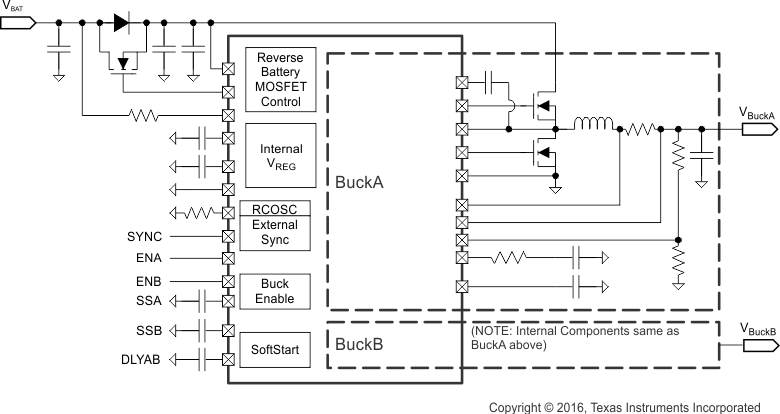SLVSAR7E June 2011 – October 2016 TPS43350-Q1 , TPS43351-Q1
PRODUCTION DATA.
- 1 Features
- 2 Applications
- 3 Description
- 4 Revision History
- 5 Pin Configuration and Functions
- 6 Specifications
-
7 Detailed Description
- 7.1 Overview
- 7.2 Functional Block Diagram
- 7.3
Feature Description
- 7.3.1
Buck Controllers: Normal Mode PWM Operation
- 7.3.1.1 Frequency Selection and External Synchronization
- 7.3.1.2 Enable Inputs
- 7.3.1.3 Feedback Inputs
- 7.3.1.4 Soft-Start Inputs
- 7.3.1.5 Current-Mode Operation
- 7.3.1.6 Current Sensing and Current Limit With Foldback
- 7.3.1.7 Slope Compensation
- 7.3.1.8 Power-Good Outputs and Filter Delays
- 7.3.1.9 Light-Load PFM Mode
- 7.3.2 Frequency-Hopping Spread Spectrum (TPS43351-Q1 Only)
- 7.3.3 Gate-Driver Supply (VREG, EXTSUP)
- 7.3.4 External P-Channel Drive (GC2) and Reverse-Battery Protection
- 7.3.5 Undervoltage Lockout and Overvoltage Protection
- 7.3.6 Thermal Protection
- 7.3.1
Buck Controllers: Normal Mode PWM Operation
- 7.4 Device Functional Modes
-
8 Application and Implementation
- 8.1 Application Information
- 8.2
Typical Application
- 8.2.1 Design Requirements
- 8.2.2
Detailed Design Procedure
- 8.2.2.1 BuckA Component Selection
- 8.2.2.2 Inductor Selection L
- 8.2.2.3 Inductor Ripple Current IRIPPLE
- 8.2.2.4 Output Capacitor COUTA
- 8.2.2.5 Bandwidth of Buck Converter fC
- 8.2.2.6 Selection of Components for Type II Compensation
- 8.2.2.7 Resistor Divider Selection for Setting VOUTA Voltage
- 8.2.2.8 BuckB Component Selection
- 8.2.2.9 Resistor Divider Selection for Setting VOUT Voltage
- 8.2.2.10 BUCKx High-Side and Low-Side N-Channel MOSFETs
- 8.2.3 Application Curves
- 9 Power Supply Recommendations
- 10Layout
- 11Device and Documentation Support
- 12Mechanical, Packaging, and Orderable Information
Package Options
Mechanical Data (Package|Pins)
- DAP|38
Thermal pad, mechanical data (Package|Pins)
- DAP|38
Orderable Information
1 Features
- Qualified for Automotive Applications
- AEC-Q100 Test Guidance With the Following Results:
- Device Temperature Grade 1: –40°C to 125°C Ambient Operating Temperature
- Device HBM ESD Classification Level H2
- Device HBM CDM Classification Level C2
- Two Synchronous Buck Controllers
- Input Range up to 40 V (Transients up to 60 V)
- Low-Power Mode IQ: 30 µA (One Buck On), 35 µA (Two Bucks On)
- Low Shutdown Current Ish < 4 µA
- Buck Output Range 0.9 V to 11 V
- Programmable Frequency and External Synchronization Range 150 kHz to 600 kHz
- Separate Enable Inputs (ENA, ENB)
- Frequency Spread Spectrum (TPS43351-Q1)
- Selectable Forced Continuous Mode or Automatic Low-Power Mode at Light Loads
- Sense Resistor or Inductor DCR Sensing
- Out-of-Phase Switching Between Buck Channels
- Peak Gate Drive Current 1.5 A
- Thermally Enhanced, 38-Pin HTSSOP (DAP) PowerPAD™ Package
2 Applications
- Automotive Infotainment, Navigation, and Instrument Cluster Systems
- Industrial or Automotive Multi-Rail DC Power Distribution Systems and Electronic Control Units
3 Description
The TPS43350-Q1 and TPS43351-Q1 include two current-mode synchronous buck controllers designed for the harsh environment in automotive applications. The devices are ideal for use in a multi-rail system with low quiescent requirements, as they automatically operate in low-power mode (consuming typically 30 µA) at light loads. The devices offer protection features such as thermal, soft-start, and overcurrent protection. During short-circuit conditions of the regulator output, activation of the current-foldback feature can limit the current through the MOSFETs for control of power dissipation. The two independent soft-start inputs allow ramp-up of the output voltage independently during start-up.
The programmable range of the switching frequency is from 150 kHz to 600 kHz, as is the frequency of an external clock to which the devices can synchronize. Additionally, the TPS43351-Q1 offers frequency-hopping spread-spectrum operation.
Device Information(1)
| PART NUMBER | PACKAGE | BODY SIZE (NOM) |
|---|---|---|
| TPS43350-Q1 | HTSSOP (38) | 12.50 mm × 6.20 mm |
| TPS43351-Q1 |
- For all available packages, see the orderable addendum at the end of the data sheet.
Typical Application Diagram
